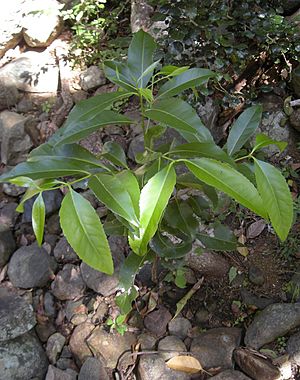Elaeodendron melanocarpum facts for kids
Quick facts for kids Elaeodendron melanocarpum |
|
|---|---|
 |
|
| Elaeodendron melanocarpum seedling. | |
| Scientific classification | |
| Kingdom: | |
| (unranked): | |
| (unranked): | |
| (unranked): | |
| Order: | |
| Family: | |
| Genus: |
Elaeodendron
|
| Species: |
E. melanocarpum
|
| Binomial name | |
| Elaeodendron melanocarpum |
|
| Synonyms | |
|
Cassine melanocarpa |
|
The Olive Plum (Elaeodendron melanocarpum) is a type of shrub or small tree found only in northern Australia. You can find it growing from The Kimberley all the way to Cape York Peninsula and even south into South East Queensland. It often grows near streams in monsoon forests and drier rainforests.
This plant used to be grouped with other plants in a genus called Cassine. But now, scientists believe that only three African plant species truly belong to the Cassine group.
What Does the Olive Plum Look Like?
The Olive Plum can grow into a small tree, reaching up to 15 meters (about 49 feet) tall. However, it's more common to see it as a bushy shrub, especially in rocky areas.
Its leaves are shiny green and grow in pairs. They are usually oval or elliptical in shape. The plant has small, white flowers. Interestingly, some flowers are male and some are female.
The fruits of the Olive Plum are black and fleshy. They can grow up to 2 centimeters (about 0.8 inches) long. Inside the fruit is a hard, stony seed, like the pit of a peach. The fruit looks a lot like an olive or a small plum. This is why it's often called the olive plum, false olive, or black olive.
Photo Gallery




